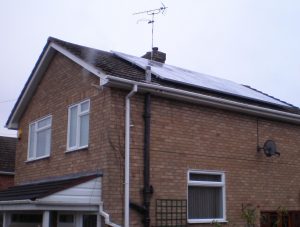Solar Electricity
Solar electric
or photovoltaic (PV) technology converts sunlight directly into electricity. This generated electricity can power your business, home or outbuildings.
If every roof in the UK were covered in Solar Panels, we could exceed the whole nation’s energy demand.
Why install a PV system?
There are many reasons to install a PV system:
[box type=”shadow”]
- Under the new “Feed in Tariffs” from April 2010 the Government will GUARANTEE to pay you a premium amount for the electricity you generate – whether you use it or not!
- An average PV system of 2.5kWp could produce as much as £929 in “income” from the Feed in Tariffs and a further £322 in savings from free electricity*
- It is the most practical cost effective option for producing carbon-free electricity
- Can easily integrated into the fabric of a building
- Electricity can be supplied at the point of use
- The system will run silently
- Requires minimal maintenance or running costs can last over 30 years
- PV systems are modular, and can be added to at any time
- Produces no carbon emissions or pollution
- Can increase the value of your property
[/box]
What is Solar PV?
The process of converting light (photons) to electricity (voltage) is called the solar photovoltaic (PV) effect. Photovoltaic solar power cells convert sunlight directly into solar power (electricity).
These solar power cells are commonly used to power everything from calculators, watches and battery chargers to road signs and security alarms.
PV solar power cells are made of semi-conducting materials similar to those used in computer chips. When sunlight is absorbed by these materials, solar energy releases energy from their atoms allowing the electrons to flow through the material to produce solar power (electricity).
It works during daylight hours – more electricity is produced when the sunshine is more intense and when it is striking the PV modules directly. However, the cells do not need to be in direct sunlight to work, so even on overcast days a PV cell will be generating some electricity.
[box type=”shadow”]
| Remember – you do NOT need planning permission to install Solar PV. Unless your property is in a conservation area, Area of Outstanding Natural Beauty or is a listed building. |  |
[/box]
How big a Solar PV system will I need?
The amount of solar electricity produced will depend upon the type of solar panel technology used, the size of available roof space, pitch of the roof, orientation, shading and budget. A typical domestic system of 2.5 kW in the UK would produce around a half of the annual demand of an average family household. However, calculating the system size depends on many factors, for example whether the system is grid connected, energy demand of the household etc.
Stand alone or grid connected?
Each system has its own advantages. Stand alone systems are particularly useful for remote locations, whether this is a shed at the bottom of the garden or an isolated dwelling. You are independent from the National Grid and can store the electricity for when it is needed in a battery bank. Most PV systems in Europe are connected to the National Grid; see Feed in Tariffs for more information
*Assumes Feed in Tariffs of £0.433 per kWh announced by the Department of Energy & Climate Change (DECC) in July 2009 and electricity cost of £0.15 per kWh; all electricity is used. If electricity is sold back to the grid or energy company, it will generate £0.03 per kWh on top of the Feed in Tariff
